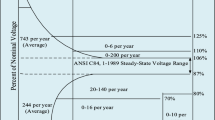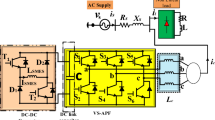Abstract
The directly coupled distributed static compensator (DC-DSTATCOM) is often utilized to achieve better power quality (PQ) in the power distribution network (PDN). However, this compensator faced challenges like poor adaptability performance and more maintenance costs due to the integration of several types of energy resources. To overcome the above-said limitations, the inductively coupled distributed static compensator (IC-DSTATCOM) using Deep Belief Learning Network (DBLN) technique is proposed. The power transfer capability of the IC-DSTATCOM is examined by considering the impedance matching principle of the distributed static compensator (DSTATCOM), source and load. Besides this, the dependent parameters are combined with the convergence factor and learning rate to achieve the approximate tuned weight by using the suggested learning mechanism. The generalized mathematical equations are illustrated using MATLAB/Simulink to generate the switching pulses. The simulation studies of both DC-DSTATCOM & IC-DSTATCOM are performed to evaluate the transient behaviour and robustness under different states of loading. The proposed system is augmented with a superior performance in terms of harmonics curtailment, improvement in power factor (p.f), load balancing, potential regulation etc. The international standard regulatory guidelines IEEE-519–2017 and IEC- 61,000–1 are imposed to evaluate the effectiveness of the simulation and d-SPACE-based experimental study.


















Similar content being viewed by others
Data availability
The authors declare that the data supporting the findings of this study are available within the paper and its Supplementary Information files.
Abbreviations
- \({N}_{1}, {N}_{1}, {N}_{3}\) :
-
Number of the turns of the primary, secondary and tertiary windings
- \({i}_{sap}, {i}_{sbp}, {i}_{scp}\) :
-
Current in the primary winding of IFCT of a, b & c-phase
- \({i}_{las}, {i}_{lbs}, {i}_{lcs}\) :
-
Current in the secondary winding of IFCT of a, b & c-phase
- \({i}_{caf}, {i}_{cbf}, {i}_{ccf}\) :
-
Current in the tertiary winding of IFCT of a, b & c-phase
- \({Z}_{sa}, {Z}_{sb}, {Z}_{sc}\) :
-
Total impedance of source and IFCT primary winding of a, b & c-phase
- \({W}_{qa}^{n},{W}_{qb}^{n},{W}_{qc}^{n}\) :
-
Reactive component of load current
- \({W}_{qa}^{i},{W}_{qb}^{i},{W}_{qc}^{i}\) :
-
Reactive ith component of load current
- \({W}_{qa}^{n-1},{W}_{qb}^{n-1},{W}_{qc}^{n-1}\) :
-
Previous reactive component of load current
- \({h}_{k}^{i-1}\) :
-
Previous ith component of somatic weight
- \({b}_{j}^{i}\) :
-
E ith component of synaptic weight
- \({W}_{pa}^{n},{W}_{pb}^{n},{W}_{pc}^{n}\) :
-
Active component of load current
- \({W}_{pa}^{i},{W}_{pb}^{i},{W}_{pc}^{i}\) :
-
Active ith component of load current
- \({W}_{pa}^{n-1},{W}_{pb}^{n-1},{W}_{pc}^{n-1}\) :
-
Previous active component of load current
- \(\sigma\) :
-
Step size
- \({u}_{pa}^{n},{u}_{pb}^{n},{u}_{pc}^{n}\) :
-
In-phase unit voltage templates of the nth component
- \({u}_{qa}^{n},{u}_{qb}^{n},{u}_{qc}^{n}\) :
-
Quadrature unit voltage templates of the nth component
- \({v}_{sa}, {v}_{sb}, {v}_{sc}\) :
-
Phase voltage
- \({v}_{t}\) :
-
PCC voltage
- \({w}_{cp}\) :
-
Output weight of DC side PI controller
- \({w}_{sp}\) :
-
Total reactive weight of the reference source current
- \({w}_{a}\) :
-
Active average value
- \({k}_{pa}\) :
-
DC side Proportional controller
- \({k}_{ia}\) :
-
DC side Integral controller
- \({w}_{cq}\) :
-
Output weight of AC side PI controller
- \({k}_{pr}\) :
-
AC side Proportional controller
- \({k}_{ir}\) :
-
AC side Integral controller
- \({v}_{te}\) :
-
Error voltage
- \({w}_{sq}\) :
-
Total reactive weight of the reference source current
- \({w}_{r}\) :
-
Reactive average value
- \({i}_{aa},{i}_{ab}, {i}_{ac}\) :
-
Active part of the reference source currents
- \({i}_{ra}, {i}_{rb}, {i}_{rc}\) :
-
Reactive part of the reference source currents
- \({i}_{sa}^{*}, {i}_{sb}^{*}, {i}_{sc}^{*}\) :
-
Total reference source currents
- CBEMA:
-
Computer Business Equipment and Manufacturing Association
- CB:
-
Circuit Breaker
- DBLN:
-
Deep Belief Learning Network
- DSTATCOM:
-
Distributed Static Compensator
- DC-DSTATCOM:
-
Directly Coupled Distributed Static Compensator
- FW:
-
Filtering Winding
- HCC:
-
Hysteresis Current Controller
- IFCT:
-
Inductively Filtering Converting Transformer
- IGBT:
-
Insulated Gate Bipolar Transistor
- NN:
-
Neural Network
- PCC:
-
Point of Common Coupling
- PDN:
-
Power Distribution Network
- P.F:
-
Power Factor
- PQ:
-
Power Quality
- PW:
-
Primary Winding
- SW:
-
Secondary Winding
- THD:
-
Total Harmonic Distortion
- VSI:
-
Voltage Source Inverter
References
Kumar, C., Mishra, M.K.: Operation and control of an improved performance interactive DSTATCOM. IEEE Trans. Industr. Electron. 62(10), 6024–6034 (2015)
Arya, S.R., Niwas, R., Bhalla, K.K., Singh, B., Chandra, A., Al-Haddad, K.: Power quality improvement in isolated distributed power generating system using DSTATCOM. IEEE Trans. Ind. Appl. 51(6), 4766–4774 (2015)
Xu, C., Dai, K., Chen, X., Kang, Y.: Unbalanced PCC voltage regulation with positive- and negative-sequence compensation tactics for MMC-DSTATCOM. IET Power Electronics 9(15), 2846–2858 (2016)
Mangaraj, M., Panda, A.K., Penthia, T. Supercapacitor supported DSTATCOM for harmonic reduction and power factor correction. IEEE Students' Conference on Electrical, Electronics and Computer Science (SCEECS), 1–6, (2016).
Mangaraj, M., Panda, A.K. and Penthia, T. Investigating the performance of DSTATCOM using ADALINE based LMS algorithm, IEEE 6th International Conference on Power Systems (ICPS), 1–5 (2016).
Mangaraj, M., Thakur, R.V., Mishra, S.K., Sabat, J., Patra, A. PQ Analysis of T-VSI and ICT-VSI with Their Impacts on 3-P 3-W Utility System, Smart Technologies for Power and Green Energy (STPGE). Lecture Notes in Networks and Systems, Springer, Singapore, 443, (2023), https://doi.org/10.1007/978-981-19-2764-5_13
Mangaraj, M., Panda, A.K.: Performance analysis of DSTATCOM employing various control algorithms. IET Gener. Transm. Distrib. 11(10), 2643–2653 (2017)
Mangaraj, M., Panda, A.K.: DSTATCOM deploying CGBP based icosϕ neural network technique for power conditioning. Ain Shams Engg. J. 9(4), 1535–1546 (2018)
Cupertino, AF., Farias, JVM., and Pereira, HA. Comparison of DSCC and SDBC modular multilevel converters for STATCOM application during negative sequence compensation, IEEE Transactions on Industrial Electronics, 66 ( 3), 2302–2312 (2019).
Mangaraj, M. and Panda, A K. Modelling and simulation of KHLMS algorithm-based DSTATCOM, IET Power Electronics, 12 (9), 2304–2311 (2019).
Zhong, C., Chen, Q., **g, Z.: Active dam** method-based self-adjust notch filter for current source converter. J. Eng. 11, 8236–8244 (2019)
Mangaraj, M., Panda, A.K., Penthia, T., Dash, A.R.: An adaptive LMBP training based control technique for DSTATCOM. IET Gener. Transm. Distrib. 14(3), 516–524 (2020)
Sabat, J., Mangaraj, M.: Experimental Study of T-I-VSI-Based DSTATCOM Using ALMS Technique for PQ Analysis. J. Inst. Eng. India Ser. B 104, 165–174 (2023). https://doi.org/10.1007/s40031-022-00812-9
Khodayar. M., Liu, G., Wang, J. and Khodayar, ME. Deep learning in power systems research: A review, CSEE Journal of Power and Energy Systems, 7 (2), 209–220 (2021).
Babu, P. N., Guerrero, JM., Siano, P., Peesapati, R. and Panda, G. An improved adaptive control strategy in grid-tied pv system with active power filter for power quality enhancement, IEEE Systems Journal, 15 (2), 2859–2870 (2021).
Fei, J. and Wang, H. Experimental Investigation of Recurrent Neural Network Fractional-Order Sliding Mode Control of Active Power Filter, IEEE Transactions on Circuits and Systems II: Express Briefs, 200; 67 ( 11), 2522–2526 (2020).
Fei, J., Chu, Y.: Double hidden layer output feedback neural adaptive global sliding mode control of active power filter. IEEE Trans. Power Electron. 35(3), 3069–3084 (2020)
Lin, F., Tan, K., Lai, Y., Luo, W.: Intelligent PV power system with unbalanced current compensation using CFNN-AMF. IEEE Trans. Power Electron. 34(9), 8588–8598 (2019)
Fei, J., Chen, Y.: Dynamic terminal sliding-mode control for single-phase active power filter using new feedback recurrent neural network. IEEE Trans. Power Electron. 35(9), 9904–9922 (2020)
Fei, J., Wang, H., Fang, Y.: Novel neural network fractional-order sliding-mode control with application to active power filter. IEEE Trans. Syst. Man Cybernet. 52(6), 3508–3518 (2022)
Faiz, M.T., et al.: Capacitor voltage dam** based on parallel feedforward compensation method for LCL-filter grid-connected inverter. IEEE Trans. Ind. Appl. 56(1), 837–849 (2020)
Fei, J., Liu, L.: Real-time nonlinear model predictive control of active power filter using self-feedback recurrent fuzzy neural network estimator. IEEE Trans. Industr. Electron. 69(8), 8366–8376 (2022)
Peng, L., Wu, W., Hu, K.: A multicell network control and design for three-phase grid-connected inverter. IEEE Trans. Industr. Electron. 68(4), 2740–2749 (2021)
Khodayar, M., Wang, J.: Spatio-temporal graph deep neural network for short-term wind speed forecasting. IEEE Trans. Sustain. Energy 10(2), 670–681 (2019)
Balouji, E., Backstrom, K., McKelvey, T., Salor, O.: Deep-learning-based harmonics and interharmonics predetection designed for compensating significantly time-varying EAF currents. IEEE Trans. Ind. Appl. 56(3), 3250–3260 (2020)
Balouji, E., Salor, O., McKelvey, T.: Deep learning based predictive compensation of flicker, voltage dips, harmonics and interharmonics in electric arc furnaces. IEEE Trans. Ind. Appl. 58(3), 4214–4224 (2022)
Khodayar, M., Wang, J.: Probabilistic time-varying parameter identification for load modeling: a deep generative approach. IEEE Trans. Industr. Inf. 17(3), 1625–1636 (2021)
Muneer, V., Biju, G.M., Bhattacharya, A.: Optimal machine-learning-based controller for shunt active power filter by auto machine learning. IEEE J. Emerging Selected Topics Power Electron. 11(3), 3435–3444 (2023)
Liu, J., Wu, W., Chung, HSH. and Blaabjerg, F. Disturbance Observer-Based Adaptive Current Control With Self-Learning Ability to Improve the Grid Injected Current for LCL Filtered Grid-Connected Inverter, IEEE Access, 7 (0), 105376–105390 (2019).
Kumar, N., Singh, B., Panigrahi, B.K.: PNKLMF-based neural network control and learning-based HC MPPT technique for multi objective grid integrated solar PV based distributed generating system. IEEE Trans. Industr. Inf. 15(6), 3732–3742 (2019)
Shukl, P., Singh, B.: Delta-bar-delta neural-network-based control approach for power quality improvement of solar-PV-interfaced distribution system. IEEE Trans. Industr. Inf. 16(2), 790–801 (2020)
Mangaraj, M., Bhoi, S.K., & Sabat, J. Deep Belief Learning Network Based IC- DSTATCOM For PQ Analysis. Int. J. Renew. Energy Res. 13(1), 184–191 (2023). https://doi.org/10.20508/ijrer.v13i1.13501.g8674
Alizadeh, R., Allen, J.K., Mistree, F.: Managing computational complexity using surrogate models: a critical review. Res. Eng. Design 31, 275–298 (2020). https://doi.org/10.1007/s00163-020-00336-7
Yang, J., Liu, Y., Bao, W., Wang, J., Li, X. and Ji, Z. A Regularized DBN Based on Fault Diagnosis Model for Inductively Coupled Plasma System. 2019 Chinese Automation Congress (CAC), Hangzhou, China, 1653–1657 (2019), doi: https://doi.org/10.1109/CAC48633.2019.8996628
Huang, W., Song, G., Hong, H., **e, K.: Deep architecture for traffic flow prediction: deep belief networks with Multitask learning. IEEE Trans. Intell. Transp. Syst. 15(5), 2191–2201 (2014). https://doi.org/10.1109/TITS.2014.2311123
Men, C. R., Dow, D. E. and Ghanavati, A. Study of the Bus Voltage Magnitude to Monitor Power Quality in the Distribution System. 2022 IEEE Electrical Power and Energy Conference (EPEC), Victoria, BC, Canada, 18(33), 2022. doi: https://doi.org/10.1109/EPEC56903.2022.10000155
Author information
Authors and Affiliations
Corresponding author
Additional information
Publisher's Note
Springer Nature remains neutral with regard to jurisdictional claims in published maps and institutional affiliations.
Rights and permissions
Springer Nature or its licensor (e.g. a society or other partner) holds exclusive rights to this article under a publishing agreement with the author(s) or other rightsholder(s); author self-archiving of the accepted manuscript version of this article is solely governed by the terms of such publishing agreement and applicable law.
About this article
Cite this article
Sabat, J., Mangaraj, M., Kundala, P.K.Y. et al. Shunt compensation using Deep Belief Learning Network Based Inductively Coupled DSTATCOM. Energy Syst (2023). https://doi.org/10.1007/s12667-023-00647-3
Received:
Accepted:
Published:
DOI: https://doi.org/10.1007/s12667-023-00647-3




